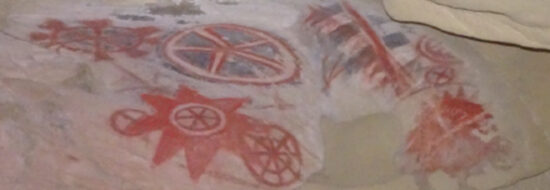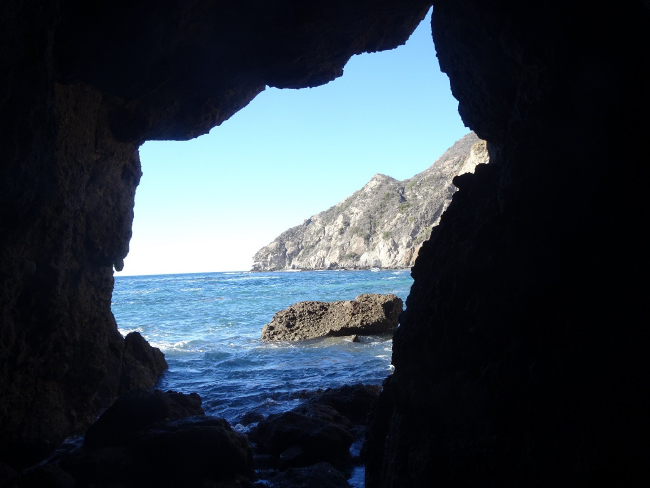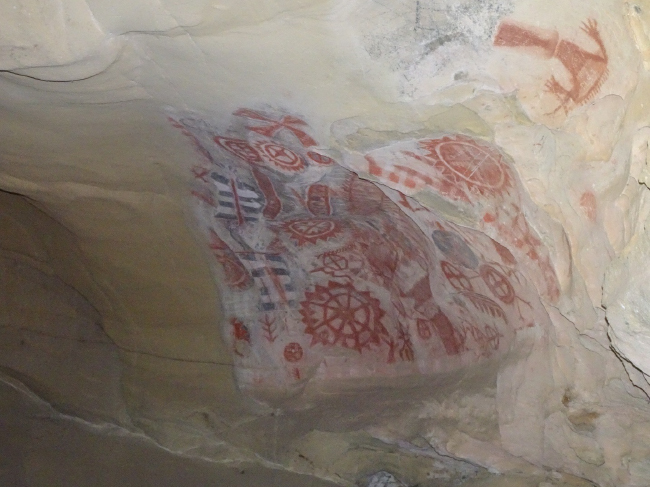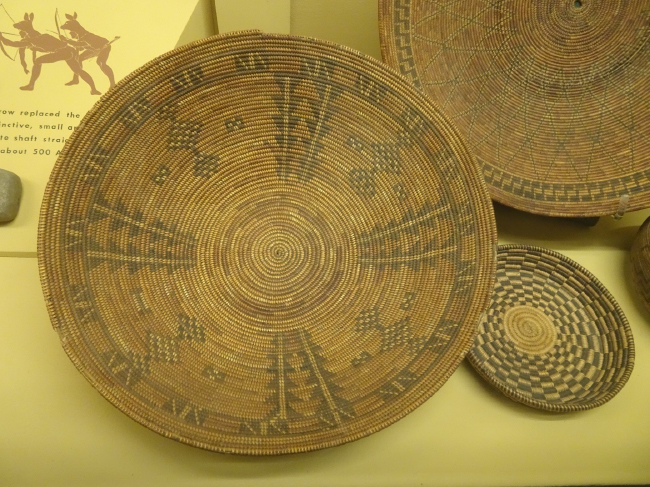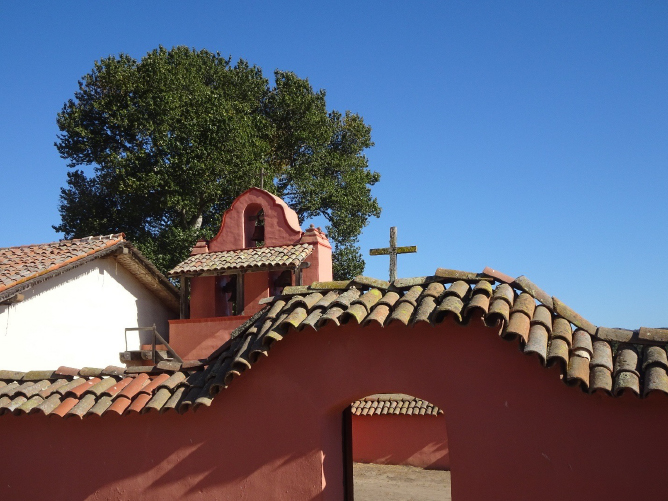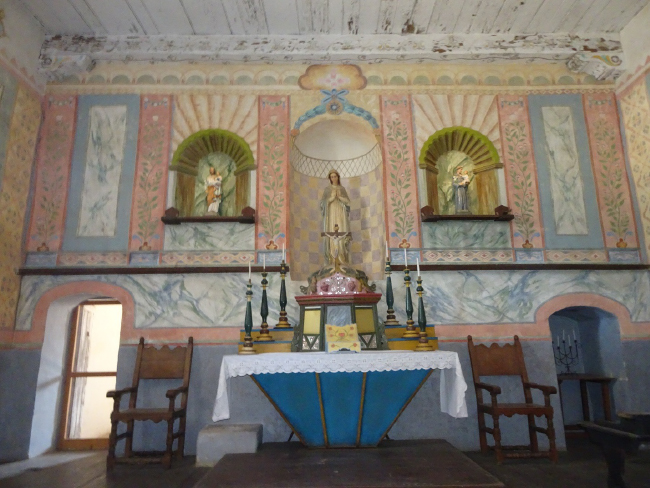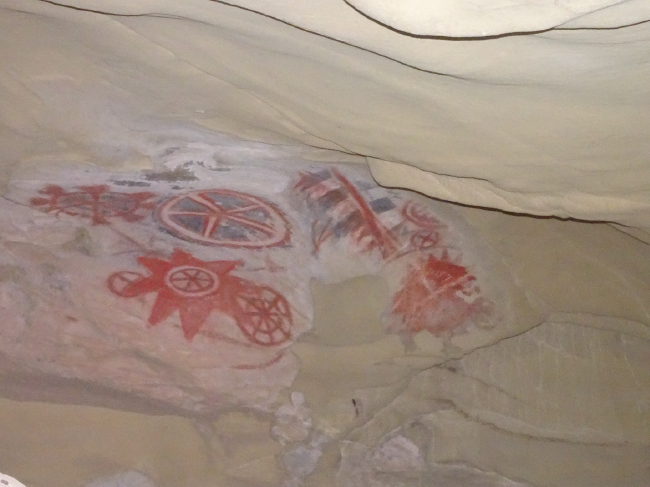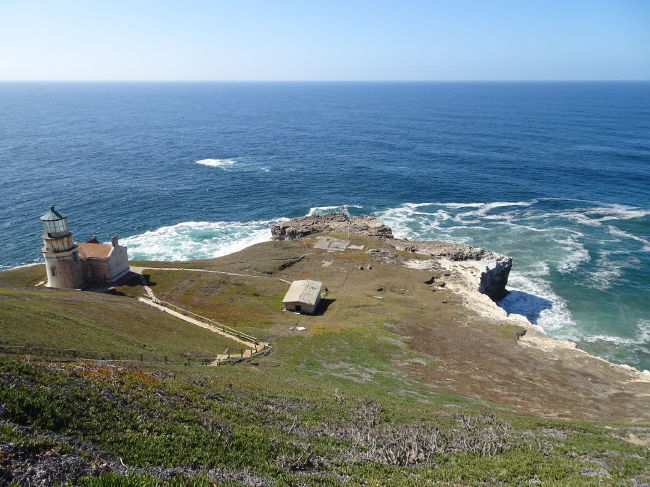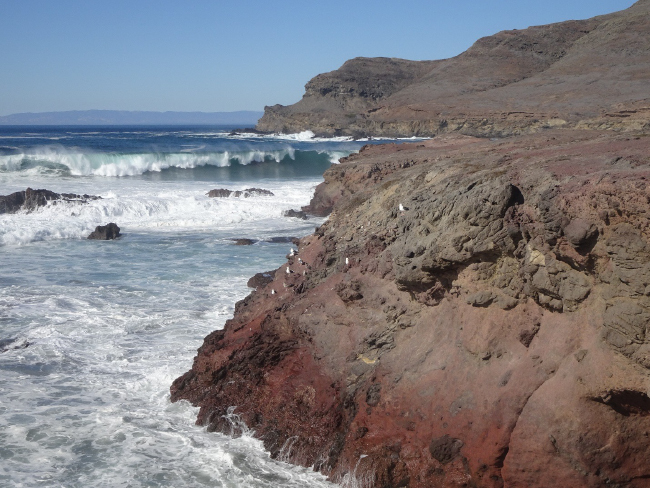The indigenous inhabitants of the island called it limuw, “in the ocean.” A prosaic but apt geographical name for the place. The name has a very matter-of-fact, here and now implication.
But the Spanish who explored the Chumash Channel and its islands beginning in the 16th century and colonized the area with their string of forts and missions beginning in the late 1700s named it La Isla de la Santa Cruz, “The Island of the Holy Cross.” The story behind the origin of the Spanish name for the place is that when the island was visited by Sebastián Vizcaíno in 1602, one of the padres with the expedition lost his staff, which was topped by an iron cross, in the Chumash town of xaxas—located at what is now called Prisoners Harbor. When the island was revisited in 1769 by a ship from the Portolá expedition, the cross was returned—supposedly having been safeguarded for almost two centuries by the Chumash inhabitants. The Spaniards apparently considered this rather miraculous, and so gave their name, now anglicized as Santa Cruz Island, to that place in the ocean.
The contrasting names span and exemplify worldviews half a planet apart: from the worldview of the deserts and myths of the Middle East (the monotheistic beliefs of the Judeo-Christian tradition) carried by the Spanish, to the equally ancient indigenous worldview of a culture that arrived in these islands from Asia more than 13,000 years ago.
_______
“What’s in a name?” Juliet asked (in her soliloquy, overheard by Romeo, in Act 2 Scene 2 of Shakespeare’s Romeo and Juliet); “That which we call a rose by any other name would smell as sweet.” We can use the words the bard had her speak to open a discussion of a question that anthropologists and linguists have been pondering for more than a century: how deeply are language, perception, and thought entwined in our ultra-verbal species? Would a rose by any other name smell as sweet?
Some Inuit and Yupik (sometimes called “Eskimo”) languages have been said to have fifty or more words for different varieties of snow. Can an English speaker even distinguish half a dozen kinds? This claim is somewhat debatable—perhaps based on the way very different languages name and describe things—but the general observation that Arctic Indigenous peoples are way better at describing snow than we are is beyond debate. On the other hand, the Tupian family of languages (some 70 languages centered in the western Amazon Basin) does not distinguish the colors blue and green, calling both oby. And the Japanese word aoi can name either blue or green. Forests and mountains can look aoi to a Japanese speaker, but so can the sea or the sky. Linguists call this phenomenon “colexification”—naming more than one “thing” with one word. But are colexified phenomena actually perceived as different things by the speakers of the languages whose words don’t distinguish them? Can speakers of Japanese or Tupi distinguish the multifold colors of green and blue that English names: lime, sage, olive, emerald; sky, navy, cobalt, teal, turquoise, and indigo?
Franz Boas, the founding father of American anthropology, cut his ethnographic “teeth” when he went to Baffin Island in 1883 to live for a year among the Inuit. His explanations of how their language was linked with their environment inspired many of his students and other anthropologists, lending support to the hypothesis that language, through both its vocabulary and grammatical structure, shapes its speakers’ perceptions and view of the world. Boas’s students Edward Sapir and Benjamin Whorf proposed that language can limit—or expand—how we see and think. This has been called the principle of “linguistic relativity,” because it was seen as having cultural implications similar to those of Einstein’s theory of relativity for the physical world.
Roots of this idea reach back to the early 19th century, when Wilhelm von Humboldt, the pioneering German linguist, stated that “The diversity of languages is not a diversity of signs and sounds but a diversity of views of the world.” Wilhelm was the elder brother of Alexander von Humboldt, the great German explorer-scientist, himself a cultural-relativist thinker, who inspired pretty much all of the founding thinkers of American environmentalism and nature conservation and… oh my gosh, we are going down a rabbit-hole into a wonderland of fascinating historical connections between worldviews and environmental philosophy that would take three or four more stories to do justice to, so I have to say no, I’m not going there right now!
_______
On another level below simple perception, at the level of “meaning,” words are the vehicles for transporting worldviews. We could ask, paralleling Juliet, “What’s in a worldview?” Would the world through every such lens look the same?
According to Matthew Vestuto, a Chumash language scholar, “Our language contains our philosophical outlook from a long, long, long time ago. You can’t understand our culture, really, through the lens of English or Spanish… you need to know the language.” Vestuto and Dr. Kristin Hoppa, the park archeologist at Channel Islands National Park, have worked together on an initiative to map and revitalize Chumash place names on the islands as a way of advancing our understanding of the cultural significance of the area; they have described it as “navigating cultural landscapes through ethnographic place names.”
A similar initiative in Anchorage, Alaska, the Indigenous Place Names Project, has put signs at 30 locations throughout the city that present and explain the Native place names for those locations. In a recent article in the Washington Post titled “We Are Still Here,” Melissa Shaginoff, an artist of Athabaskan and Paiute ancestry associated with the project, explained her view of its purpose: “It’s very much digging deeper than just renaming a place. It’s about this sort of reclamation of an incredible, incredibly old and relevant information system that is Indigenous languages. Our language is the most perfectly designed language for that space, for that area, and there’s so much knowledge embedded in that.” It’s a bold claim: that an indigenous language is culturally evolved and adapted to “fit” a place or an ecosystem, much as a species or subspecies that inhabits a place is adapted to it because of natural selection by ecological and evolutionary forces.
_______
And so we come to the view from limuw, the name for the largest of the California Channel Islands in the language of its most recent non-European inhabitants, the Chumash. It’s time to try to dig deeper, like linguistic archeologists, into language and myth, to seek the roots of the Chumash worldview as it was before Spanish contact and colonization.
Worldviews—how we think and feel about our place in nature—shape our individual and collective behavior, and thus the effect we humans have on the ecosystems and the biosphere we inhabit. My research on the history and ecology of the Cascade Head Biosphere Reserve led me to three general conclusions, or “lessons” as I called them in the title of my book about the place (Byers, 2020). One lesson was that “worldviews matter” because of their influence on our planet and ourselves.
The “worldview” of a culture—a direct translation of the German word Weltanshaung that first described this concept—is expressed through its language, through stories invented, retold, and passed down the generations—perhaps with cultural “mutations,” and selection and rejection of those new bits and pieces to create a better “fit” between the human cultural worldview and the actual natural world.
Our history turns first to John Peabody Harrington, the anthropologist who documented most of what we know about Chumash language and culture. In my last essay “The Chumash Channel and Its Islands” I sketched Harrington’s biography. He entered Stanford University as an undergrad in 1902, majoring in anthropology and classical languages, but “While taking a summer class at the University of California, Berkeley, he came under the influence of Alfred Kroeber, then working on his encyclopedic study of California Indians. Kroeber’s lectures electrified Harrington. Almost immediately, he became obsessed with Indian languages and ethnography” (Fagan, 2003, p. 329). Harrington’s academic pedigree lies firmly within the academic family-tree of Franz Boas and his students Edward Sapir and Benjamin Whorf, and he is clearly aligned with their hypothesis of linguistic relativity.
And then we turn to Thomas C. Blackburn, whose 1975 book December’s Child: a Book of Chumash Oral Narratives, compiled many of the stories, legends, and myths recorded by Harrington, and then abstracted postulates or elements of the Chumash worldview from the narratives. I’ve never seen an attempt to reconstruct a worldview from ethnographic texts like this before (although perhaps it has been done and I’m ignorant of those efforts). I’m impressed!
Blackburn defines “worldview” as “the explicit and implicit beliefs held by a society about the nature of man, the universe and of man’s relations to the universe and his fellow man”—similar to how I conceive it. He goes on to say that “Within this general frame of reference two major types of postulates or basic assumptions can then be distinguished that apparently provide the members of the society with criteria for choosing between alternative courses of action. Existential postulates are statements about the nature of things, the what and how of existence, while normative postulates are concerned with desirable states and goals, with what “should be” rather than with what “is.” Existential and normative postulates are for the most part mutually consistent and reinforcing: in fact, one set should logically be derivable from the other through careful analysis” (Blackburn, 1975: pp. 63-64).
As far as “the nature of things,” the Chumash saw themselves as part of what Blackburn calls a “personalized universe,” in which the natural environment, including “plants, animals and birds, celestial bodies, and various natural forces are all part of the social universe to which man belongs, and their activities and interests may vitally affect the course of human events” (p. 66). Within that eco-social universe, the members “share reciprocal rights and responsibilities with respect to one another and comprise the membership of a structured community reinforced by bonds of kinship and mutual dependency.” This sounds to me like John Muir, who frequently talked about plants and animals as people and as his kin, or Aldo Leopold writing about the “biotic community.”
Another existential postulate of the Chumash worldview, says Blackburn, is the “assumption of negative-positive integration.” Thus, “good and evil are not mutually exclusive categories, nor is the sharp dichotomy between the two, familiar to Western society, of any great relevance to daily life” (p. 68). As a consequence, because positive and negative elements are present in all phenomena, “the universe is considered both dangerous and unpredictable… full of dangers that one can only hope to avoid through a judicious combination of knowledge and prudence” (p. 69). This echoes the yin and yang ideas of Chinese Taoism (or Daoism as it is spelled in the official modern Chinese pinyin romanization system).
And still another postulate about the nature of reality identified in the Chumash worldview concerns space and time; this one leans in a decidedly relativistic, Einsteinian direction. “Subjective time in the realm of the sacred may be quite different than that experienced by man, or it may be virtually meaningless to any structured reality,” and “Normal spatial parameters can, with sufficient power, be transcended” (p. 71). Chumash shamans (like those of other Eurasian and North American Indigenous cultures) were thought to be able to travel rapidly in time and space to gather intelligence about the forces affecting or likely to affect the here and now.
And a final existential postulate, the “assumption of a dynamic equilibrium of oppositions.” This one is a relative of the aforementioned “assumption of negative-positive integration,” but emphasizes the dynamic effects of that yin-yang integration. “For the Chumash, the great forces of nature are in a constant state of balanced opposition to one another, with none possessing an ultimate superiority that might irrevocably alter the proper condition of dynamic equilibrium that should normally prevail in the universe” (p. 72).
The contrast between these existential postulates of the Chumash worldview and the Western worldview is stark. In one culture we see a unified, non-dual material-spiritual world (Chumash); in the other a dualistic, material-spiritual dichotomy (Western). One pictures a world of immanent gods and powers; the other a lone transcendent God. In one world humans and all creatures are interrelated and equal; in the other, humans are favored and given domination over all others. For one culture, time is relativistic and cyclical; for the other, it is linear and historical. In one worldview, good and evil are seen as inseparable—perhaps creative—partners; in the other worldview it’s a war between God and Satan, good and evil.
After laying out the existential elements of the Chumash worldview, Blackburn turns back to the body of stories, legends, and myths collected by Harrington from his Chumash informants for a look at their ethical or normative elements, listing thirteen specific postulates. Blackburn’s names for these ethical values include knowledge, prudence, self-constraint, moderation, reciprocity, industriousness, pragmatism, and etiquette. To me these sound like the ethical values and norms of a humble, hard-working, communitarian culture—almost the antithesis of our arrogant, acquisitive, individualistic society today.
_______
La Purísima Mission State Historic Park in Lompoc, California, claims to be the most completely and authentically restored of all of California’s historic missions. A section of its excellent interpretive museum portrays the collision of Western and Indigenous worldviews here. The Spanish worldview at the time of contact with the Chumash is characterized as “glory, God, and wealth.” The Chumash worldview is described as one of “faith, stability, and prosperity.”
The first of a chain of what would eventually become 21 missions in California was established in 1769 in San Diego by the Franciscan priest Junipero Serra. Six missions in Chumash territory, the first at Ventura in 1782 and the last at Santa Ynez in 1804, rapidly destroyed the fabric of Chumash culture, both economically and politically. The missions—each with both church and priests and forts and soldiers—were supposed to be economically self-supporting enterprises, and they immediately injected an Old World, European agricultural system into the previously non-agricultural, complex hunter-gatherer society of the Chumash. Chumash were lured to the missions with gifts of cloth, trinkets, metal tools, and cheap glass beads—which quickly devalued the indigenous shell bead money—and were conscripted for labor on the mission farms. Old World crops like wheat and barley, and fruits like apples, pears, and peaches were introduced, and Old World livestock—sheep, cattle, pigs, and horses—grazed, trampled, and degraded the rich wild ecosystems that had provided the Chumash with food for thousands of years. Mission enterprises produced European-style goods such as tallow, candles, soap, hides, leather, wool, and blankets for trade mainly with other Europeans and Euro-Americans.
In barely over half a century since the first mission was established in Chumash territory, Chumash society had basically collapsed. Was it really that fragile? Since it had lasted so long, it is hard to imagine that it was. “Guns, germs, and steel” is a common formulation of the forces that destroyed so many indigenous societies around the world, derived from the title of the best-selling, prize-winning book by Jared Diamond, Guns, Germs, and Steel: The Fates of Human Societies, published in 1997. Certainly, guns helped Spanish soldiers enforce the conscription of Chumash people, and their population had certainly been dramatically reduced by European diseases to which they had no previous exposure, and so no acquired or evolved immunity. But Erik Davis, author of The Visionary State: A Journey Through California’s Spiritual Landscape, has reformulated Diamond’s phrase slightly, but significantly, to describe the triple-threat brought by the Spanish to the Chumash as “guns, germs, and God” (Davis, 2006, p. 12).
_______
At a bend in Highway 154 as it climbs toward the San Marcos Pass in the Santa Ynez Mountains above Santa Barbara, I turned sharply up Painted Cave Road, dutifully following the verbal orders from the assertive but gentle female voice guiding me from Google Maps on my iPhone. The road was steep and winding and at the switchbacks gave wonderful views over Santa Barbara and the Chumash Channel. In a narrow, dark canyon there was a tiny pullout where only a few cars could park, and a sign by the road identified the place as the Chumash Painted Cave State Historic Park. A metal cage covered the cave mouth to protect its pictographs from vandals. In the late afternoon shade of the canyon the cave itself was pitch black, and no paintings were visible. At first, I resigned myself to a wasted trip, but then I thought of my camera and its flash, and tried taking a few flash photos into the cave, aiming randomly. Scrolling through the images, I saw that one of them had caught an edge of some bright designs—I was suddenly seeing the invisible. With more attempts I slowly corrected my aim into the dark and in the photos was able to see what my eyes could not see directly and immediately. Vibrant mysterious spoked wheels and swirling suns seemed to be the dominant motif. So what was the worldview represented there? How do those images hint at it? What do they mean?
I thought of a passage from Erik Davis’s book, The Visionary State: “One message of California’s rock art seems clear: humanity’s most fundamental sacred space is nature itself… and the extreme cleavage between architecture and the natural landscape…the sharp divide of all our built sacred architecture, may ultimately reflect our longing for the sort of Paleolithic intimacy that once characterized our relationship to the ordinary world” (Davis, 2006, p. 16).
According to Chumash language scholar Matthew Vestuto, Harrington’s informant Fernando Librado Kitsepawit is recorded as saying “I’ve always believed what the old ones told me when I was a child, that the world is God. When they translated “Dios” or God to Chumash, they used the word hesup, meaning ‘this world.’ So our concept of god was a little larger… or more grounded” (Vestuto, 2020).
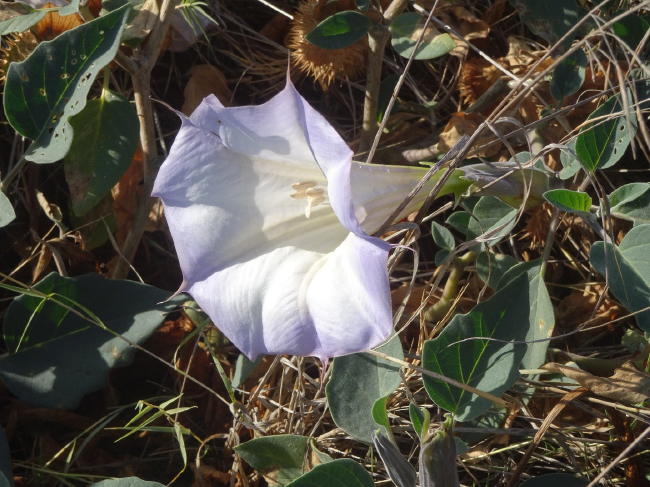
_______
The dominant Western worldview of human supremacy stems from the Biblical creation myth of Genesis 1:27, shared by the Middle Eastern monotheisms (Judaism, Christianity, and Islam), which pictured “man” created in the image of “God,” assumed to be the pinnacle of value in the universe, and charged with “dominion” over all of nature. This kind of anthropocentric monotheism is not a common worldview; it is an outlier among the diverse spiritual, religious, and philosophical traditions documented by anthropologists. The Western, human-supremacist worldview has often been viewed as the deep root cause of our current ecological crisis (for example by Aldo Leopold, 1966; Lynn White Jr., 1967; Gary Snyder, 1990; and Eileen Crist, 2019).
The humans-dominant dogma of Genesis evolved (culturally) among sparsely populated pastoral tribes wandering the relatively harsh and unproductive ecosystems of the Middle East, who fought for water and grass with other tribes, each of whom believed their own god was on their side. As the human population exploded with the invention of irrigated crop agriculture in that region, tribes banded into kingdoms and empires, still fighting for scarce natural resources; the humans-dominant worldview still worked as a tool for land and resource competition. Later cultures and empires of the Mediterranean world, especially the Romans, refined this worldview still further as a political instrument. Their offspring-cultures colonized most of the planet from Holland, England, Portugal and Spain, and European technology and alien diseases allowed the anthropocentric, human-supremacist worldview to overwhelm many locally adapted worldviews around the globe, especially perhaps in the New World. This can be seen as the cultural equivalent of an alien invasive species—picture prickly pear cactus or rabbits in Australia, for example—taking over previously diverse, well-adapted ecosystems because of their competitive ability. In the process of European colonization, much of the delicate cultural evolution of worldviews that had adapted humans to the diverse ecoregions of the biosphere was lost (along with the languages that carried them), just as so much biological evolution has been and is being lost as biological species become extinct.
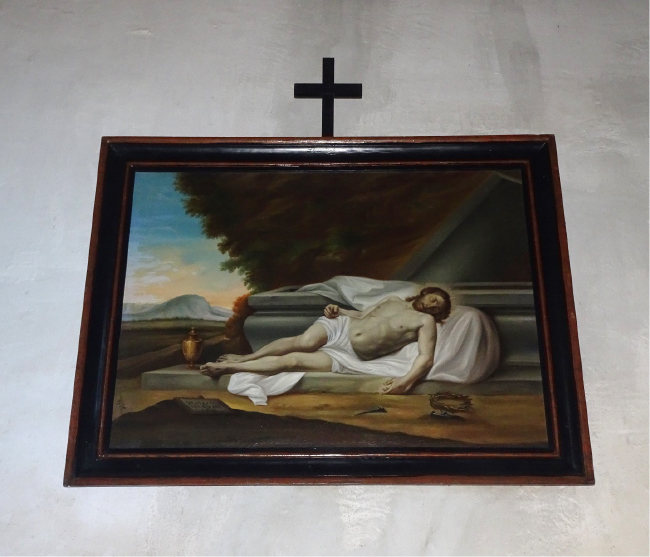
The Western, human-supremacist worldview has been highly “fit” at conquering and colonizing the planet. The erstwhile “success” of the anthropocentric worldview now threatens our own species with potential extinction. That worldview has become highly maladaptive, and needs to be replaced.
Cultural evolution, like biological evolution, is creative. It uses bits of cultural legacy and new cultural “mutations” to craft new combinations. It can create new worldviews. And we need that to happen now. Two sources of raw material for this urgently needed cultural evolution are available. One source is the old worldviews, or fragments of them, that managed to survive the invasion and onslaught of the Western worldview. The other source is an important cultural “mutation” that arose within the Western tradition itself—science. Of particular importance in shaping emerging science-based worldviews is the science of evolutionary ecology, which clearly places humans on a tiny branch of the huge evolutionary family, at the same evolutionary “level” at this point in time with all our relatives, from viruses and bacteria to beetles, mushrooms, bats, and ants—and not “higher” or “lower” than any of them.
_______
I’ve heard about Point Conception since I was in high school, when I first attended a marine science camp in Oregon and read Between Pacific Tides, the “bible” of Pacific intertidal ecology by Edward F. Ricketts. After sweeping south along the Pacific Coast from Alaska, the cold California Current passes Point Conception, sweeps past the Channel Islands, and goes farther offshore, allowing a countercurrent of warm water from the south to flow up past southern California into the California Bight. The change in water temperatures creates a marine biological divide, and influences onshore ecosystems as well. But I never had the chance to go there until now. The Nature Conservancy’s new Dangermond Preserve lies just north of the Santa Barbara (Chumash) Channel along the Gaviota coast and turns north at Point Conception toward San Luis Obispo and the Big Sur coast. TNC’s stewardship manager at the preserve, Moses Katkowski, took me to see that place I had always wanted to see on a glorious mid-October day.
For the Chumash, Point Conception, called humqaq, was one of the most sacred places in their homeland. Here, according to their mythology, was the jumping-off point for the souls of the dead on their journey to the afterworld across the ocean, Šimilaqša. They made their way here to this point, bathed in a pool at its base below the cliffs, and departed to the western heaven. Maria Solares of Santa Ynez, one of Harrington’s main informants, told him that “Three days after a person has been buried the soul comes up out of the grave. Between the third and fifth days it wanders around the world, visiting the places it used to frequent in life” (Blackburn, 1975, p. 98). On the fifth day after death, it goes to humqaq, which Solares said is a “wild and stormy place. In ancient times no one ever went near humquq,” only to a great shrine nearby. Below the cliffs of the point is a pool where the spirit of the dead person bathes and paints itself, said Solares. “Then it sees a light to the westward and goes toward it through the air, and thus reaches the land of Šimilaqša.”
One version of the story (Applegate, 1974, p. 200) says that when the dead souls reached humqaq, ravens pecked out their eyes, and they groped on the ground until they plucked golden-orange poppies, which they put into their empty eye sockets so they could see their way to Šimilaqša. When they arrived there, the poppy eyes were replaced with blue-green abalone shell.
When my time comes, I’ll be ready for the journey. Just imagine! To see the world anew through eyes of nacreous blue!
_______
When I first came across references to the Chumash story “Crossing the Rainbow Bridge,” it struck me as a parable for our time, this time, of humans on Earth. Here’s the story:
The first human people were made by Hutash, the Earth Goddess, on limuw, the place now called Santa Cruz Island. Life was kind of hard for them, until they got fire from Hutash’s husband, Sky Snake—the Milky Way—who had a tongue like a lightning bolt. One day he decided to give them a gift and he licked the ground with his tongue and started a fire. The people learned to tame this fire and things were a lot easier. They could cook food and keep warm in the winter, and their villages started to get bigger and bigger… and life was so much easier they spent more time having more and more babies. But Hutash was getting annoyed; limuw was getting crowded, and the noise the people made was keeping her awake at night. She decided some of the people would have to leave the island and move to the mainland, where there weren’t any human people living in those days. To get them over there she made a bridge from a rainbow that went from the top of the highest peak on the island, Mount Diablo, to a high peak near what is now called Carpinteria. She sent some people over the Rainbow Bridge to settle on the mainland, and told them not to look down while crossing over, because it was a long way down and they might get scared and fall off. But sure enough, some of the people were curious and didn’t follow Hutash’s instructions, and they looked down and fell off into the channel. Hutash felt bad about that, so she turned them into dolphin people and they didn’t die.
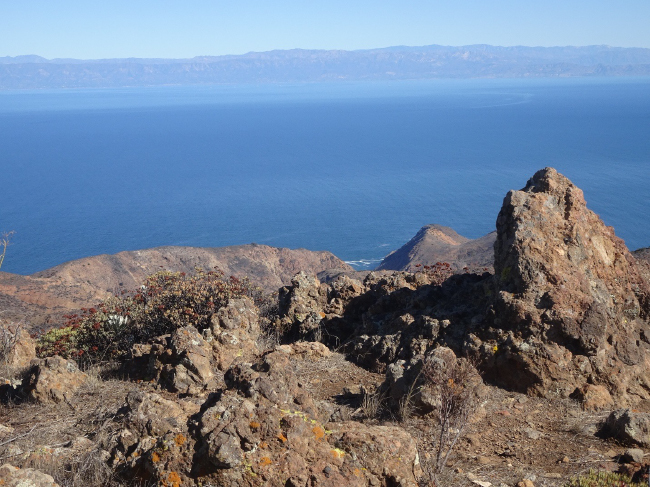
Since first hearing this story, I have become aware of differences of opinion among Chumash scholars about its source and authenticity. The fact that it was not recorded by Harrington from his informants makes some of them skeptical, but others attribute it to authentic sources. In any case, this story is such an eloquent parable for our planetary predicament that if the Chumash were not its source, somebody would have to invent it. Greg Sarris, a writer of Miwok and Pomo heritage from Sonoma County, California, has done something like that perhaps, channeling the tone and wisdom of his culture into a delightful book of modern fables, How A Mountain Was Made.
We can invent new stories, legends, myths, as needed, to motivate us and guide us. Worldviews are living, evolving, adaptive cultural creations, not dead dogmas fixed in the past.
The Rainbow Bridge legend is an apt metaphor for “Earth Island” now. We humans have bred ourselves up to a population of almost eight billion on Island Earth. Thanks to Sky Snake, we evolved our control of fire into learning how to burn up all the “fossil fuel” energy stored in the ecosystems over millions of years in a couple of centuries. Yes, we’ve now had a carefree time of breeding of burning, but there are way too many of us and we have changed the climate of our little island. Not to mention the noise!
Where will we go, to escape the ecological problems of our own making? Where will Hutash, the Earth Goddess who created us, send us on a new Rainbow Bridge? To colonize Mars, another planet on the “mainland” of our Solar System? Or perhaps further afield, to other planetary systems around other stars in our galactic neighborhood?
I’m not counting on it. On those journeys we are bound to look down… and I can’t picture space dolphins. There is no other place for us than this tiny island called Earth anywhere in the universe, so we have to live here, and take care of it.
_______
Worldviews are the result of cultural evolution. Similar in some fundamental ways to biological evolution, the process of cultural evolution depends on cultural variation, “mutations” if you will, that is replicated and selected within a particular socioecological environment over long periods of time. Perhaps worldviews should be seen as the equivalent of something like the “classes” or “orders” of biological phylogeny—like mammals, birds, or fish, for example–or even higher taxonomic levels, like “phylum”—mollusks or vertebrates. If worldviews have evolved to allow human cultures to survive in a given environment, they should be somehow adaptive. And, like biological adaptations, they could lose their adaptive benefits as their ecological context changes.
In an essay in my book about the Cascade Head Biosphere Reserve in Oregon, I argued that indigenous worldviews are as unique and valuable—and as worthy of conservation and restoration—as endangered biological species. I wrote: “And worldviews! What about worldviews, created by the evolution of human experience in the natural world, giving guidance about how to maintain harmonious relationships with nature? Language and culture are the bearers of those worldviews. And we need to know and conserve that diversity of worldviews more than ever now, as we seek reconciliation with the biosphere, and a path to resilience.”
The UNESCO Man and the Biosphere (MAB) Programme, created in 1971, established a network of “biosphere reserves,” distributed across the diverse ecosystems of the planet, where we could monitor and understand the effects of human activities, and develop models and strategies for conserving or restoring natural ecosystems while still meeting human social, cultural, and economic needs. Biosphere reserves, in other words, are supposed to be laboratories, models, and nuclei for spreading successful strategies for healing the human-nature relationship. A half-century since it was established, the international network of UNESCO biosphere reserves now includes 714 sites in 129 countries. There are currently 28 biosphere reserves in the United States that participate in the MAB Programme, of which the Channel Islands Biosphere Reserve is one.
If biosphere reserves are to be laboratories for improving and healing the human-nature relationship, they must experiment with solutions not only to the short-term, proximate causes of the problem, but also the deeper, fundamental root causes—such as the now globally-dominant, human-supremacist, Western worldview. Could biosphere reserves be laboratories for the restoring or developing ecocentric worldviews, and nuclei from which they could spread and expand? My optimistic view is “yes.” In my work as an international ecological consultant I’ve had the opportunity to work in 34 biosphere reserves in 17 countries around the world. Although each is unique, they all face similar kinds of challenges and provide lessons for all the others. In several of them I have found examples of indigenous, non-Western, ecocentric worldviews, and seen evidence that those can influence human behavior and practices that affect the environment.
For example, in the Middle Zambezi Biosphere Reserve in northern Zimbabwe, my research showed that traditional Shona spiritual values have protected areas of “sacred” forests (Byers, et al., 2001). In the Sierra Nevada de Santa Marta Biosphere Reserve in northern Colombia, several indigenous ethnic groups have mapped the area from the perspective of their cultural worldview. They aim to raise awareness about traditional sacred sites and how they could guide plans and policies that would benefit “all beings in nature…so that balance is maintained on earth, life is preserved and there is a true harmony between: cold and heat, day and night, winter and summer, life and death, man and nature and man with man” (Organización Gonawindúa Tayrona, 2012). Those and many other examples give me hope that biosphere reserves can not only help us understand and address the short-term, proximate causes of the ecological crisis we’ve created, but also address the deep root cause of our problem, our human-supremacist worldview.
My working hypothesis that UNESCO biosphere reserves can be places where old or new ecocentric worldviews can be restored, revitalized, and/or invented to adapt to current challenges in our relationship with our planet. Channel Islands Biosphere Reserve could be one laboratory for doing this urgent work.
For related stories see:
- The Chumash Channel and its Islands, January 2022.
- The Art of Ecological Restoration on Santa Cruz Island, January 2022.
- Evolutionary Ecology on California’s Galapagos, January 2022.
- More Ecological Explorations at the Edge of the Continent, December 2021.
Sources and other links:
- National Park Service Channel Islands National Park. 2021.
“Santa Cruz Island – limuw.” - Vestuto, Matthew. 2017. Interview for Santa Barbara Historical Museum exhibit “Sacred Art in the Age of Contact: Chumash and Latin American Traditions in Santa Barbara.”
- Trabant, Jürgen. “How relativistic are Humboldt’s “Weltansichten”?”, in Pütz & Verspoor, 2000.
- Hoppa, Kristin, and Matthew Vestuto. 2020. “Navigating Cultural Landscapes through Ethnographic Place Names.” Western National Parks Association (video presentation)
- Indigenous Place Names Project, Anchorage Park Foundation, Anchorage, AK
- Hedgpeth, Dana, and Rachel Hatzipanagos. “We are still here.” Washington Post, November 19, 2021.
- Byers, Bruce A. 2020. The View from Cascade Head: Lessons for the Biosphere from the Oregon Coast. Oregon State University Press, Corvallis, OR, USA.
- Fagan, Brian. 2003. Before California: An Archaeologist Looks at Our Earliest Inhabitants. AltaMira Press, Walnut Creek, CA, USA.
- Blackburn, Thomas C. 1980. December’s Child: A Book of Chumash Oral Narratives. University of California Press, Berkeley, CA, USA.
- Jones, W.T. 1972. “World Views: Their Nature and Their Function.” Current Anthropology, Feb., 1972, Vol. 13, No. 1 (Feb., 1972), pp. 79-80+81-109
- Duncan, Owen. 2021. “A Chumash Basket Returns to Chumash Land.” Santa Barbara Museum of Natural History.
- La Purísima Mission State Historic Park, Lompoc, CA
- California Missions. History.com, 2018.
- Spanish missions in California. Wikipedia.
- Diamond, Jared. 1997, 1999. Guns, Germs, and Steel: The Fates of Human Societies. W.W. Norton and Company: New York and London.
- Davis, Erik. 2006. The Visionary State: A Journey through California’s Spiritual Landscape. Chronical Books, San Francisco, CA, USA.
- Chumash Painted Cave State Historic Park, Santa Barbara, CA
- Datura wrightii
- Entheogen
- Leopold, Aldo. 1966. A Sand County Almanac with Essays on Conservation from Round River. New York, NY: Sierra Club/Ballantine Books, Inc.
- White, Lynn. 1967. “The Historical Roots of Our Ecological Crisis.” Science 155: 1203-1207.
- Snyder, Gary. 1990. The Practice of the Wild. San Francisco: North Point Press.
- Crist, Eileen. 2019. Abundant Earth: Toward an Ecological Civilization. University of Chicago Press. Chicago, IL, USA.
- Dangermond Preserve, The Nature Conservancy
- Applegate, Richard B. 1974. “Chumash Placenames.” Journal of California Anthropology, 1 (2): 187-205.
- Tumamait-Stenslie, Julie. “The Rainbow Bridge Story.” Film by Channel Islands National Park and Community Access Partners of San Buenaventura.
- https://www.wilderutopia.com/traditions/myth/chumash-story-seeds-of-creation-and-the-rainbow-bridge/
- National Park Service Channel Islands National Park. 2016 “Limuw: A Story of Place.” Written story excerpted from: The Chumash People: Materials for Teachers and Students. Santa Barbara, CA: Santa Barbara Museum of Natural History, 1991.
- Byers, Bruce A., Robert M. Cunliffe, and Andrew T. Hudak. 2001. “Linking the Conservation of Culture and Nature: A Case Study of Sacred Forests in Zimbabwe.” Human Ecology 29: 187-218.
- Organización Gonawindúa Tayrona. 2012. Jaba y Jate: Espacios Sagrados del Territorio Ancestral Sierra Nevada de Santa Marta. (Spanish).

